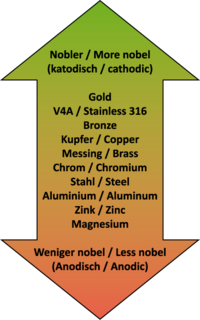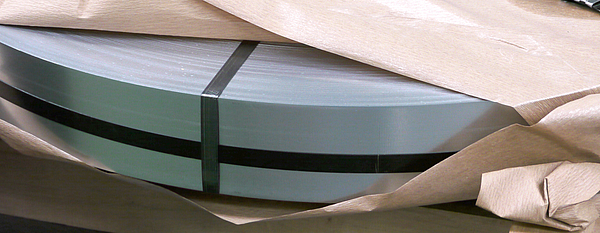Galvanized Steel
Galvanized Steel Strips
Hot dip galvanized,
Sendzimir galvanized
DX 51 D × Z 140 MA according to DIN EN 10 142 (Zinc coating thickness ≈ 10 µm per side).
DX 51 D × Z 275 MA according to DIN EN 10 142 (Zinc coating thickness ≈ 20 µm per side), upon request.
Temperature Resistance: (Zinc coating Z: 140 to 275 g/m2)
Up to max. 200°C. When the zinc coating is subject to temperatures above 200°C on a sustained basis, the so called “Kirkendal” voids between the steel and the zinc layer might occur, leading to the flaking of the zinc surface. For a continuous / sustained use we therefore recommend a maximum temperature of 150°C.
Electro-galvanized Parts
Some parts, such as bolts, nuts, springs, G-clamps, drive-clamps and corner pieces can only be electro galvanized. The zinc layer thickness varies between 5 and 10 µm on each face, and the temperature resistance is limited to a maximum of 80°C. Please take into consideration the lower corrosion resistance.
Corrosion and Temperature Resistances
The below information is valid for all products described as being made of galvanized steel.
The edges of cut are not galvanized. In a relatively humid environment corrosion might occur on sheet metal thickness of 1,2 mm and above, and already on 1.0 mm sheet metal thickness in very humid environments.
The sheet metal is dip galvanized and the zinc coating relatively important. Additional parts such as corner pieces, installation elements, nuts and bolts, rivets, curved joining clip bolts, shells, and others are electro galvanized. The zinc coating is between 0,008 and 0,010 mm thick, making these parts less resistant to corrosion.
Also to be noted is that the zinc coating might become damaged through assembly and/or other operations such as spot welding, welding, the use of rivets and self-piercing screws or bolts.
The corrosion resistance also depends on the temperature. The zinc coatings can be different depending on the product components (i.e. hot dip galvanized vs. electro galvanized). Higher temperatures can have a negative influence on the coatings and even destroy them. Above 200°C is the corrosion resistance of hot dip galvanized slit stripes no longer guaranteed. Above 80°C the corrosion resistance of electro-galvanized parts (such as bolts and nuts) can be negatively affected, and there is no corrosion resistance above 120°C.
Electro-galvanic Corrosion
It is important to check the compatibility of the various materials in order to avoid corrosion. The potential electro-galvanic corrosion (which appears when different materials are put in contact) must be assessed.
See also DIN EN 12944
What is Galvanic or Electro-Chemical Corrosion?
A natural, electro-chemical process takes place when different metals touch each other. In that process particles of the anodic metal are released (the material is eaten away or corroded; a process also called oxidation) while the cathodic metal remains intact. This phenomenon speeds up as the temperature rises, in humid areas and under water. The greater the potential difference between the metals, the higher the probability and speed at which electrogalvanic corrosion will occur. To prevent electro-galvanic corrosion from taking place one must isolate the different metals from each other.
Cathodic: protected when in contact with a less noble metal
Anodic: corrodes first when in contact with a nobler metal

